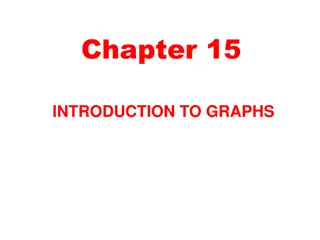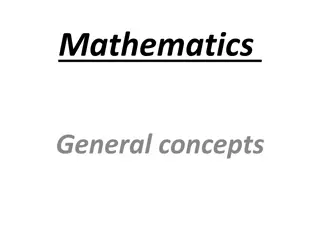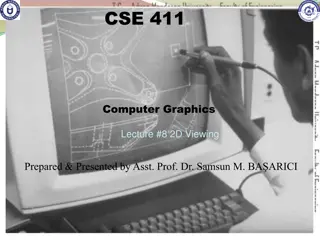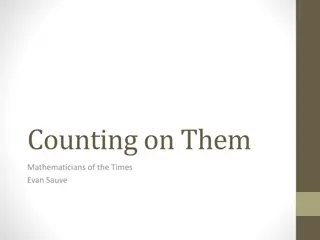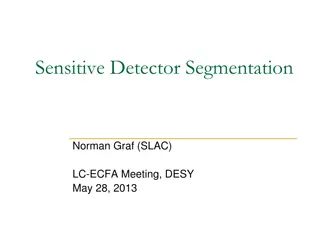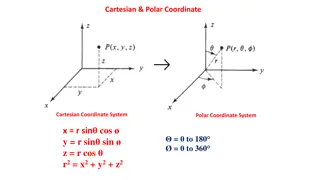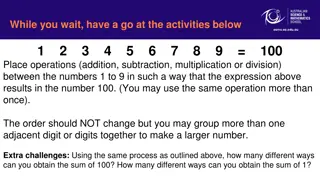
Understanding Cartesian Coordinates and Linear Functions
Explore the concepts of Cartesian coordinates, gradients, linear functions, and relationships between lines in two dimensions. Learn about slopes, intercepts, and parallel/perpendicular lines through detailed explanations and examples.
Download Presentation

Please find below an Image/Link to download the presentation.
The content on the website is provided AS IS for your information and personal use only. It may not be sold, licensed, or shared on other websites without obtaining consent from the author. If you encounter any issues during the download, it is possible that the publisher has removed the file from their server.
You are allowed to download the files provided on this website for personal or commercial use, subject to the condition that they are used lawfully. All files are the property of their respective owners.
The content on the website is provided AS IS for your information and personal use only. It may not be sold, licensed, or shared on other websites without obtaining consent from the author.
E N D
Presentation Transcript
Cartesians For a given point P, a line is drawn through P perpendicular to the x- axis to meet it at X and second line is drawn through P perpendicular to the y-axis to meet itat Y. The coordinatesof P are X and Y interpreted as numbers x and y on the corresponding number lines. The coordinates are written as an ordered pair (x, y). The value of x is called the x- coordinate or abcissa and the value of y is called the y-coordinate or ordinate.
Gradient Y the slope or gradient of a line describes its steepness, incline, or grade. A higher slope value indicates a steeper incline. The slope is (in the simplest of terms) the measurement of a line, and is defined as the ratio of the "rise" divided by the "run" between two points on a line . B(x2,y2) A(x1,y1) X 0
Example Suppose a line runs through two points: A(3, 2) and B(8, 4) . By dividing the difference in y-coordinates by the difference in x-coordinates, one can obtain the slope of the line:
Linear Function Formula : y = mx + c Ax + By + C = 0 Point slope formula, throughs (x1, y1) with m : The Secant line between two points(x1, y1) dan (x2, y2) dengan
Example (1) Suppose a line runs through two points: (-4, 2) and (6, -1) . 1stWay : Gradien : If through (-4, 2) then : (form : y =mx +c) (form : Ax+By+C=0)
2ndway : form: Ax + By + C = 0 form : y = mx + C
Example (2) Through (6, -1)
Lines Parallel lines parallel lines have the same slope and lines with the same slope are parallel. m1=m2 Perpendicular lines If you visualize a line with positive slope, then the perpendicular line must have negative slope So perpendicularslopes have opposite signs. m1.m2= - 1
Hubungan Dua Garis x- dany- Intercepts : an x-intercept is a point in the equation where the y-value is zero, and a y-intercept is a point in the equation where the x-value is zero.
Example One line passes through the points ( 1, 2) and (1, 2); another line passes through the points ( 2, 0) and (0, 4). Are these lines parallel, perpendicular, or neither? Since these two lines have identical slopes, then these lines are parallel.
One line passes through the points (0, 4) and (1, 7); another line passes through the points (3, 0) and ( 3, 2). Are these lines parallel, perpendicular, or neither? If I were to flip the "3" and then change its sign, I would get " reciprocals, so the lines perpendicular. 1/3". In other words, these slopes are negative through the points are
One line passes through the points (4, 2) and (0, 3); another line passes through the points ( 3,-2 ) and (3, 2) Are these lines parallel, perpendicular, or neither?
Example : Find the x- and y- intercepts of 25x2+ 4y2= 9 Using the definitions of the intercepts, I will proceed as follows: x-intercept(s): y = 0 for the x-intercept(s), so: 25x2+ 4y2= 9 25x2+ 4(0)2= 9 25x2+ 0 = 9 x2=9/25 x = (3/5) Then the x-intercepts are the points (3/5, 0) and ( 3/5, 0) y-intercept(s): x = 0 for the y-intercept(s), so: 25x2+ 4y2= 9 25(0)2+ 4y2= 9 0 + 4y2= 9 y2=9/4 y = (3/2) Then the y-intercepts are the points (0,3/2) and (0, 3/2)
Examples : Graph y = ( 5/3)x 2 T-chart Graph
Drawn line equation: y = 2x + 3 the number on x is the slope, so m = 2 for this line. If, say, x = 0, then y = 2(0) + 3 = 0 + 3 = 3. Then the point (0, 3) is on the line
Graph y = 3 It doesn't matter what x-value you pick; you will always be 3.
Problem : Drawn : Graph y = 2x Graph 4x 3y = 12
garisy = 2x 4x 3y = 12 5 4 y = 2x 3 (1,2) 2 1 (0,0) 2 1 -2 -1
Menggambar Grafik Persamaan Kuadrat (Parabola) Untuk menggambar suatu persamaan kuadrat, ikuti tiga langkah berikut : 1. Tentukan titik-titik potong dengan sumbu-sumbu koordinat : Titik potong dengan sumbu x, syaratnyay = 0 Titik potong dengan sumbu y, syaratnyax = 0 2. Tentukan titik balik/puncak parabola, titik puncak dilalui sumbu simetri, koordinatnya adalah : dimana 3. Gambarkan beberapa titik lagi untuk membantu mempermudah penggambaran, kemudian hubungkan titik-titik tersebut dengan sebuah kurva mulus.
Find new equality thats through (6, 8) and paralel with 3x 5y = 11 3x - 5y = 11 or , m = 3/5 m2 = 3/5 2ndline : through (6, 8) and m2 = 3/5
5y = 3x + 22 atau 3x 5y + 22 = 0 (6,8) 8 3x-5y=11 11/3 6 -11/5
The Distance Formula Distance between A dan B : A(x1, y1) Example : Find the distance between the points A (-2, 3) dan B (4, -1) B(x2, y2)
Jarak Titik Ke Garis Distance between T(x1,y1) to Ax + By + C = 0 adalah : P(x1,y1) d Example : Find the distance between the points A (1, 2) to 4x + 5y + 8 = 0
Latihan Tentukan gradien garisyang melalui titik (2, -4) dan (0,-6) 2. Tentukan persamaangaris : a) Melalui titik (2, 3) dengan kemiringan 4 b) Melalui titik (2, 3) dan (4, 8) 3. Tuliskan persamaangaris melalui (3, -3) yang : a) Sejajargaris 2x + 3y = 6 b) Tegak lurus garis 2x + 3y = 6 c) Sejajargarisyang melalui titik (-1, 2) dan (3, -1) 4. Tentukan persamaan garis yang melalui titik potong garis- garis 2x + 3y = 4 dan -3x + y = 5 dan tegak lurus dengan garis pertama. 5. Diketahui titik A(1, 2), B(3, -4), dan C(-2, 0). Tentukan persamaangarisyang melalui titik A dan sejajargaris BC. 1.





